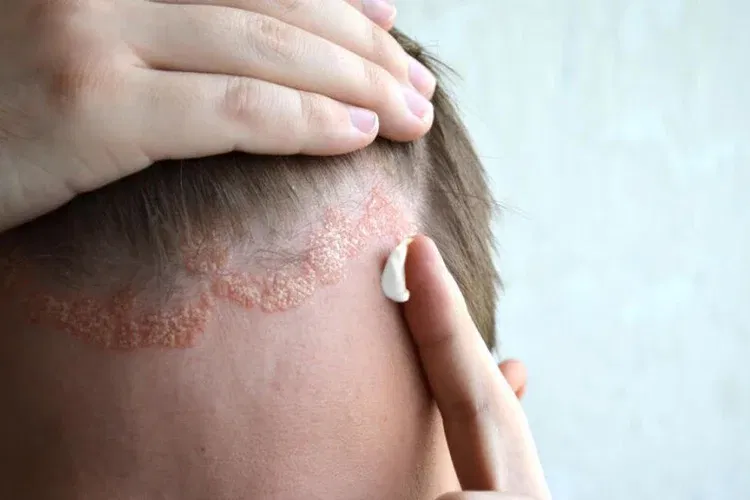
Discovering a strange bump or lesion on your child’s scalp can be alarming especially when getting a doctor’s appointment isn’t immediately possible. While professional evaluation is always best, having some basic understanding of common scalp issues can help you manage symptoms at home and decide when medical attention is necessary.
This guide summarizes frequent scalp conditions, with a special focus on psoriasis vulgaris – a common but often misunderstood disorder. You’ll learn how to recognize scalp psoriasis, try simple home remedies, explore over-the-counter options, identify red flags, and document symptoms effectively for your healthcare provider.
1. Understanding Scalp Conditions
The scalp is a sensitive area that can develop many different problems, from harmless dandruff to chronic skin disorders. Genetics, hygiene habits, environment, and infections all play roles. For example, seborrheic dermatitis often causes greasy flakes and redness due to yeast overgrowth. Folliculitis, an infection in hair follicles, leads to red, pus-filled bumps. Because many scalp conditions appear similar, proper identification helps guide treatment.
2. Common Causes of Scalp Bumps
Scalp bumps have numerous origins. Seborrheic dermatitis produces yellowish, itchy scales. Folliculitis creates small, tender, inflamed bumps caused by bacteria or fungi. Pilar cysts—benign, fluid-filled sacs—can also appear, sometimes growing large. Psoriasis, a chronic autoimmune condition, causes thick, raised patches topped with silvery scales. Understanding these possibilities can help you narrow down what you’re seeing.
3. Psoriasis Vulgaris 101

Psoriasis vulgaris is the most widespread type of psoriasis. It occurs when the immune system mistakenly accelerates skin-cell growth, forming red, scaly plaques that may itch or crack. Although incurable, psoriasis can be controlled. Genetics, stress, infections, cold weather, and certain medications can spark flare-ups. Knowing these triggers helps with long-term management.
4. How to Identify Scalp Psoriasis
Scalp psoriasis typically appears as well-defined reddish patches coated with silvery-white scales. These plaques may cross the hairline and cause itching, burning, or temporary hair thinning due to scratching. Unlike seborrheic dermatitis, which looks greasy and diffuse, psoriasis plaques tend to be thicker and more sharply outlined. Recognizing these clues can help you determine whether psoriasis may be the cause.
5. Helpful Home Remedies
Several simple home strategies can ease mild symptoms. Coconut oil or aloe vera can moisturize and soften thick scales when left on for a few hours or overnight. Diluted apple cider vinegar may reduce itching thanks to its natural antiseptic qualities. Controlled sunlight exposure while avoiding burns can also slow rapid skin-cell turnover. These remedies aren’t cures, but they can offer meaningful relief.
6. Over-the-Counter Treatments
OTC products are often effective for mild to moderate scalp psoriasis. Coal tar shampoos slow skin growth and reduce scaling. Salicylic acid helps loosen and remove thick plaques. Mild topical corticosteroids can reduce itching and inflammation when used carefully. Follow product instructions closely, and speak with a pharmacist if unsure which option is best.
7. When to See a Doctor
Even with home care, some situations require medical evaluation. Seek help if symptoms worsen, do not improve after several weeks, or interfere with sleep and daily routines. Signs of infection such as spreading redness, pus, fever, or severe pain need immediate attention. A dermatologist can confirm the diagnosis and recommend prescription treatments such as stronger steroids, medicated foams, or light therapy.
8. Managing Scalp Psoriasis at Home

Long-term management relies on consistency. Regular moisturizing reduces scaling and dryness. A home humidifier keeps air moist, benefiting sensitive skin. Identifying and avoiding triggers—stress, smoking, harsh hair products, or certain foods—can prevent flare-ups. Keeping a symptom diary helps track patterns. Gentle hair care, including soft-bristle brushes and avoiding tight hairstyles, prevents irritation and breakage.
9. Popular Viral Scalp Hacks
Some trending remedies can be surprisingly helpful when used with caution. Tea tree oil, known for antifungal and anti-inflammatory benefits, can be added (sparingly) to shampoo. A baking-soda paste may gently exfoliate d3ad skin and reduce scales. Always patch-test new treatments to avoid adverse reactions, and discontinue if irritation occurs.
10. Documenting Symptoms for Your Doctor
Clear documentation helps your provider make an accurate diagnosis. Record when symptoms began, how intense they are, and any itching, scaling, or pain. Note possible triggers such as stressful events, illness, or new products. Taking well-lit photos every few days helps track changes especially useful if appointments are delayed.















